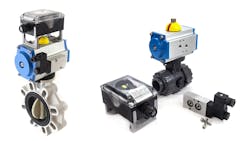A new research report from MarketsandMarkets estimates the global motion control component market will achieve a compound annual growth rate (CAGR) of 5.2% between 2022 and 2027. Growing adoption of automation is in manufacturing is seen as a key driver for this.
The research firm expects the market to increase from its current value of $15.5 billion to $20.0 billion by 2027.
Use of motion control technologies such as motors, drives, sensor devices and software in manufacturing facilities are rising as a consequence of the global COVID-19 pandemic. MarketsandMarkets states in its press release announcing the release of this research that the increase is brought about by a growing need for high-precision automated processes, and a rising focus of governments on enforcing stringent measures to ensure workplace safety.
Related technologies such as the Internet of Things (IoT), artificial intelligence (AI) and machine learning are also growing to aid with automation.
READ MORE: IoT Enables Better Problem Solving in Fluid Power
Labor Challenges Drive Automation Growth
The need for automation in manufacturing is growing due to a lack of skilled labor entering the market—a challenge many industries are facing. Older generations are retiring and there are fewer people from younger generations taking over those roles. Automation is seen as a way of helping to overcome this by potentially attracting new workers interested in working with advanced technology as well as enabling work to be completed with fewer employees.
While a challenge before the pandemic, COVID-19 exacerbated it in many ways by causing people to retire sooner or leave the industry for a different type of job. Many people are still struggling with childcare and concerns over safety in the workplace, as well, adding to the labor challenges. In addition, new variants are causing continued health concerns and more lockdowns in parts of the world, such as China.
Demand for goods remains high, necessitating the use of automation where possible to continue meeting the world's need for products of various types.
Motors to Account for Largest Market Share
According to MarketsandMarkets' new report, motors are forecast to hold the largest market share within the motion control industry. This is due to manufacturers' desire to use more energy-efficient motors as a means of improving their operational costs and environmental footprint.
The research firm states in its press release that energy-efficient motors also provide enhanced performance compared to standard motors in terms of winding, quality of laminations and other areas. All of these aspects help lead to improved operating costs.
MarketsandMarkets notes motors can be found in a wide range of applications including:
- semiconductor & electronics,
- food processing,
- petrochemicals,
- pharmaceuticals,
- healthcare,
- packaging, and
- paper & printing.
Motion Control for Closed-Loop Systems to See Fastest Growth
The new research report also finds that closed-loop control systems, also known as feedback systems, will see the fastest growth during the forecasted period. MarketsandMarkets says in its press release the adoption of closed-loop systems is high as the process is automated, and lack of human intervention reduces the chance for errors.
Because a closed-loop system can automatically adjust based on desired output, manufacturers can see improvements such as:
- system stability
- reduced system sensitivity
- increased robustness
- reliability.
Asia Pacific to be Key Market
MarketsandMarkets is projecting Asia Pacific to be the region with the fastest growth for the motion control industry. This is due to increasing urbanization and industrialization which are causing more demand for motion control technologies.
Rising adoption of automation technologies such as robots is also driving the increased need for motion control components. Increased demand for smartphones and automobiles which require use of motion control systems to assemble parts like semiconductors and electronics is also driving growth in the region.
About the Author
Sara Jensen
Executive Editor, Power & Motion
Sara Jensen is executive editor of Power & Motion, directing expanded coverage into the modern fluid power space, as well as mechatronic and smart technologies. She has over 15 years of publishing experience. Prior to Power & Motion she spent 11 years with a trade publication for engineers of heavy-duty equipment, the last 3 of which were as the editor and brand lead. Over the course of her time in the B2B industry, Sara has gained an extensive knowledge of various heavy-duty equipment industries — including construction, agriculture, mining and on-road trucks —along with the systems and market trends which impact them such as fluid power and electronic motion control technologies.
You can follow Sara and Power & Motion via the following social media handles:
X (formerly Twitter): @TechnlgyEditor and @PowerMotionTech
LinkedIn: @SaraJensen and @Power&Motion
Facebook: @PowerMotionTech

Leaders relevant to this article:


